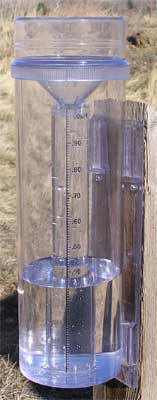 SWOP Rainfall Measurement Tips
SWOP Rainfall Measurement Tips
Rainfall data received from the SWOP network is used in a variety of ways at the National Weather Service in Lincoln. Your reports can be utilized to enhance routine short-term forecast products, and can even serve as the impetus for issuing a number of flood watch and warning products. In addition, rainfall reports provide excellent ground truth, allowing forecasters to assess the accuracy of Doppler radar rainfall estimates. Given the wide range of uses for your rainfall data, accurate readings are extremely important. This guide will provide useful tips for properly measuing rainfall with your National Weather Service issued 4-inch rain gauge.
Tip #1: Place the gauge in an open area
The rain gauge must be placed in an open area away from obstructions such as trees, buildings, garages, etc. It also needs to be far enough from your house to prevent wind currents flowing around/over the structure to distort your measurement. An ideal location would be on a fence post well away from your house or any trees.
Tip #2: The gauge must be level
To obtain a proper rainfall reading, please ensure your gauge is level.
Tip #3: Proper gauge height
Try to place your gauge at a height of no greater than 5 feet. This allows minimum impact from nearby structures.
Tip #4: Empty your gauge regularly
You can check your gauge periodically during a rainfall event, but once the rain is over, be sure to take one final measurement, then empty your gauge. This will ensure an accurate reading the next time it rains.
Tip #5: Take your gauge inside for the winter
The plastic inner-tube of your gauge is particularly sensitive to freezing conditions, and can easily crack if left outside with water in it during subfreezing conditions.
Tip #6: Reading your gauge correctly
Your NWS 4-inch rain gauge will hold exactly 1 inch in the inner cylinder. If rainfall exceeds this amount, it will overflow into the outer container. To properly measure the rain, first dump out the inner cylinder, then carefully pour the contents of the outer portion of the gauge into the inner tube. Add the amounts together for your final total. The entire rain gauge has a capacity of 11 inches.
Tip #7: Proper rainfall reporting
After taking a careful rainfall measurement, please relay the data to us as soon as possible. The preferred method is via the SWOP e-mail account at: nwsliilx@noaa.gov Rainfall should be reported in hundredths of an inch (i.e 0.08, 0.27, 0.50, 2.61)
Within the SWOP program, we encourage observers to take rainfall readings periodically through an event...then provide a storm-total once the rain has stopped.